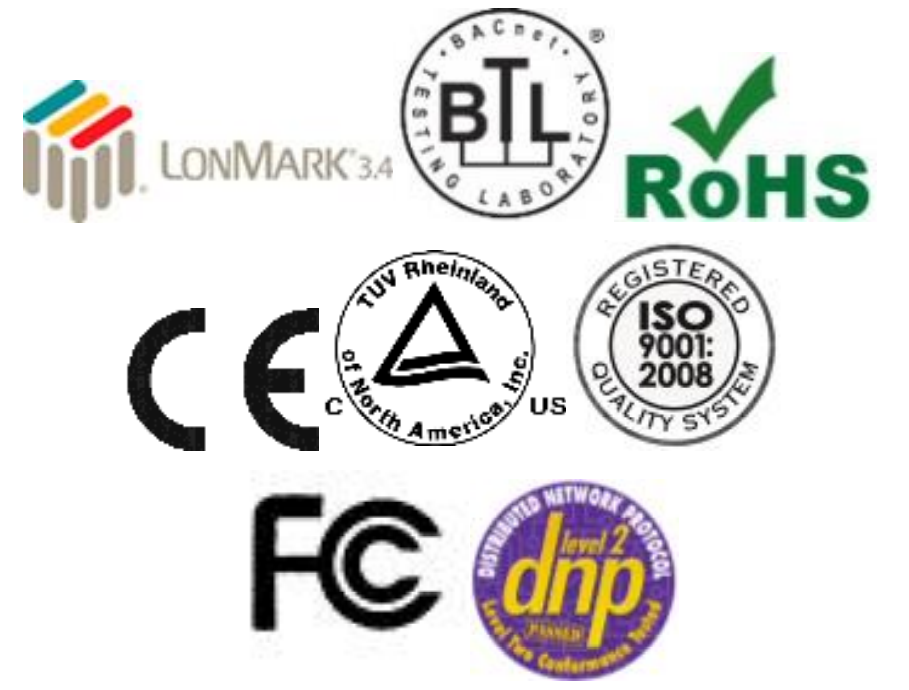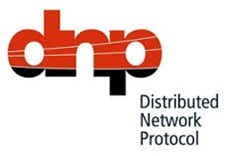Multiport Gateway (Serial-Ethernet-LonWorks)
This protocol translator/gateway provides a wealth of features to enable data transfer between different devices and networks utilizing serial, Ethernet or LonWorks ports. The extensive library of FieldServer drivers provides easy interoperability with devices and networks used in building automation, HVAC, fire and process control industries.
The FS-B3510 is one of the FS-X30 Series FieldServers designed to meet the needs of system integrators in designing a complete interoperable system. The FS-B30 Series brings together the powerful FieldServer driver library with state-of-the-art gateway design. This FieldServer includes four serial connections (two RS-232, two RS-485), two Ethernet ports, and a LonWorks port. The multiport design allows for serial-to-serial interfaces or interface from mulitple serial products to an Ethernet or LonWorks network. The two Ethernet ports enable the integrator to connect a PC to download configuration changes without disturbing the system connections and without the additional cost of an external hub.
Veeder-Root
The Veeder-Root Serial Driver allows the FieldServer to transfer data to and from devices over either RS- 232 or RS-485 ports using Veeder-Root protocol as defined in Veeder- Root Document 576013-635 Revision J. The Veeder-Root Driver supports TLS350 as per Veeder-Root Document 576013-635 Revision Y, and TLS450 as per Veeder-Root Document 577013-950 Revision G. Since the data protocol is the same for the TLS-350+ as for TL-S350, it is assumed that the driver will support the TLS350+ but this has not been tested. The Driver also successfully communicates with the TLS-450 as it has the same data protocol. Please refer to the driver manual for hardware connections.
The FieldServer emulates a Client.
The Veeder-Root Serial Driver is a poll response driver. Only one query or command can be processed at a time.
A limited set of the queries and commands defined in the protocol specification have been implemented. The reason for the limitation is two-fold. Firstly, not all commands/queries will have any meaning to a Server device as they are principally defined to configure the Veeder-Root Device. Secondly, some commands return very complex data sets which cannot be processed in a method suitable for loading into the FieldServer’s Data Arrays.
The driver is capable of exposing its communications statistics which allows them to be monitored using a Server device.
Supported Veeder-Root products
The Veeder-Root Gateway supports the following Veeder-Root Products:
- TLS-450 PLUS Automatic Tank Gauge
- TLS4i / TLS4c Automatic Tank Gauge
- TLS-350 Automatic Tank Gauge
- TLS-350 Plus Automatic Tank Gauge
- TLS-350R Automatic Tank Gauge
- TLS-300C/I Automatic Tank Gauges
- TLS-2/P Automatic Tank Gauge
DNP3.0 Ethernet
The Ethernet DNP 3.0 driver allows the FieldServer to transfer data to and from devices over Ethernet using DNP 3.0 protocol. The FieldServer can emulate either a Server of Client. The DNP 3.0 Ethernet Driver adheres to and supports the framework specified by the IEEE 1815-2012 Standard for electrical power system communications.
The following information was copied form the DNP 3.0 User Group Internet site.
The development of DNP3 was a comprehensive effort to achieve open, standardsbased Interoperability between substation computers, RTUs, IEDs (Intelligent Electronic Devices) and master stations (except inter-master station communications) for the electric utility industry. Also important was the time frame; the need for a solution to meet today's requirements. As ambitious an undertaking as this was, we reached this objective. And since the inception of DNP, the protocol has also become widely utilized in adjacent industries such as water / waste water, transportation and the oil and gas industry.
DNP3 is based on the standards of the International Electrotechnical Commission (IEC) Technical Committee 57, Working Group 03 who have been working on an OSI 3 layer "Enhanced Performance Architecture" (EPA) protocol standard for telecontrol applications. DNP3 has been designed to be as close to compliant as possible to the standards as they existed at time of development with the addition of functionality not identified in Europe but needed for current and future North American applications (e.g. limited transport layer functions to support 2K block transfers for IEDs, RF and fiber support). DNP3 has been selected as a Recommended Practice by the IEEE C.2 Task Force; RTU to IED Communications Protocol.
DNP3 is an open and public protocol. In order to ensure interoperability, longevity and upgradeability of, protocol the DNP3 Users Group has taken ownership of the protocol and assumes responsibility for its evolution. The DNP3 Users Group Technical Committee evaluates suggested modifications or additions to the protocol and then amends the protocol description as directed by the Users Group members.
DNP3 Features: DNP3 offers flexibility and functionality that go far beyond conventional communications protocols. Among its robust and flexible features DNP3 includes:
- Output options
- Secure configuration/file transfers
- Addressing for over 65,000 devices on a single link
- Time synchronization and time-stamped events
- Broadcast messages
- Data link and application layer confirmation
DNP3 was originally designed based on three layers of the OSI seven-layer model: application layer, data link layer and physical layer. The application layer is objectbased with objects provided for most generic data formats. The data link layer provides for several methods of retrieving data such as polling for classes and object variations. The physical layer defines most commonly a simple RS-232 or RS-485 interface.
DNP3 is very efficient for a layered protocol while ensuring high data integrity
DNP3 Benefits: Because DNP3 is based on the IEC 870-5 requirements, DNP3 is suitable for application in the entire SCADA environment. This includes RTU to IED communications, master to remote communications, and even peer-to-peer instances and network applications.
Being an object-based application layer protocol, DNP3 has the flexibility to support multiple operating modes such as poll-response, polled report-by-exception, unsolicited responses and peer-to-peer. It permits multiple masters and encourages distributed intelligence.
Users can expect many benefits from using DNP3. In the short term:
- Interoperability between multi-vendor devices
- Fewer protocols to support in the field
- Reduced software costs
- No protocol translators needed
- Shorter delivery schedules
- Less testing, maintenance and training
- Improved documentation
- Independent conformance testing
- Support by independent users group and third-party sources (e.g. test sets, source code)
Specifications
Multiport Gateway (Serial-Ethernet-LonWorks)
Field Connections
- Ethernet Ports – 2: 100 BaseT RJ45 connector (auto MDIX and sensing) with ESD protection
- Serial Ports – 5: 2 x RJ45 RS-232 galvanically isolated with ESD protection. 2 x RS-485 galvanically isolated with ESD protection. 1 x RJ45 RS-232 system port.
- LonWorks – 1: FTT-10 twisted pair. 1000 Network variable capability. LonWorks service pin
- Auxiliary ports – 2: 2 x USB ports. Expansion: Fieldbus connectors available for selected protocol
Environment
- Operating Temperature: 0-60°C (32-140°F)
- Relative Humidity: 10-90% non-condensing
Power Requirements
24V AC (+/-10%) or 12-30V DC @ 12W
Physical Dimensions
- Dimensions (WxDxH): 6.3x5.4x2.0 in.(16.0x13.7x5.0cm)
- Weight: 2.5 lbs (1.5 Kg)
- Input voltage: 24 V DC nominal: 10-30V DC
Other
Configuration/Diagnostic utilities
- Capacity: Base system has 1000 point capability (upgradeable to 10,000 points)
- Mounting Options: Desktop, Wall, Panel Optional: DIN rail
LED Indicators
Power, Run, System Error, Configuration Error, and Node Offline
Ethernet connection– Link OK, Tx/Rx communication activity
RS-232/RS-485 – Tx/Rx communication activity
LonWorks - Activity
Communication, Option, Drivers
Memory upgrade for additional data points
Custom Configuration Service
Drivers available for a wide range of Ethernet and social protocols
Approvals
- CE Marked
- CSA Certified: UL916 Standard and CSA @ 22.2
- DNP 3.0 Tested
- RoHS Compliant
- GOST-R Certified
- FCC: Part 15
- LonMark Certified
- Modbus Tested
- BTL Certified

Manuals
Datasheets
Case Studies
Resources
Articles
Veeder-Root - Printing Setup Report
Lonworks - Can you show me an example of typical FieldServer / QuickServer Veeder Lonworks points
How do I Change the Connection Parameters on a Veeder Root TLS – 3XX Panel
Veeder-Root - How do I find a typical list of points served for TLS (Veeder) Data
Veeder-Root - How to print Veeder-Root Setup Report for TLS-300 and TLS-350
Veeder-Root: Decoding TLS-350 Series In-Tank Inventory Terminology
Case Study - Modbus RTU and Veeder Root to Ethernet IP
Useful Links
Logos



SqrdresizedWTBG__80917.1712846605.png?c=2)
SqrdresizedWTBG__80917.1712846605.png?c=2)


